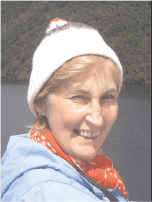Using palaeogeographic reconstructions to understand lithological variability within the Early Cretaceous Gage Sandstone and South Perth Shale in the Vlaming Sub-Basin, offshore southern Perth Basin
Megan Lech A , Chris Southby A , David Lescinsky A , Luiqi Wang A , Diane Jorgensen A , Irina Borissova A and Stephen Johnston AGeoscience Australia.
The APPEA Journal 54(2) 535-535 https://doi.org/10.1071/AJ13108
Published: 2014
Abstract
The Early Cretaceous Gage Sandstone and South Perth Shale formations are a prospective reservoir-seal pair in the Vlaming Sub-basin. Plays include post-breakup pinch-outs in the Gage Sandstone with the South Perth Shale forming top seal. The Gage reservoir has porosities of 23–30% and permeabilities of 200–1,800 mD. It was deposited in palaeotopographic lows of the Valanginian breakup unconformity and is the lowstand component of the thick deltaic South Perth (SP) Supersequence. To characterise the reservoir-seal pair, a detailed sequence stratigraphic analysis was conducted by integrating 2D seismic interpretation, well log analysis and new biostratigraphic data. Palaeogeographic reconstructions for the SP Supersequence were derived from mapping higher-order prograding packages and establishing changes in sea level and sediment supply. Higher resolution Gage reservoir reconstructions were based on seismic facies mapping. The Gage reservoir forms part of a sand-rich submarine fan system and ranges from canyon confined inner fan deposits to middle fan deposits on a basin plain. Directions of sediment supply are complex, with major sediment contributions from a northern and southern canyon adjacent to the Badaminna Fault Zone. The characteristics of the SP Supersequence differ markedly between the northern and southern parts of the sub-basin due to variations in palaeotopography and sediment supply. Palaeogeographic reconstructions reveal a series of regressions and transgressions leading to infilling of the palaeo-depression. Palaeogeographic reconstructions for the SP Supersequence portray a complex early post-rift depositional history in the central Vlaming Sub-basin. The developed approach is applicable for detailed studies of other sedimentary basins.

In 2001, Megan Lech completed a BSc (honours) in geology from the Australian National University and joined Geoscience Australia as a graduate. She has conducted basin analysis studies at Mt Isa and at the offshore North Perth Basin, and she also coordinated the offshore Petroleum Acreage Release product. In 2011, Megan gained an MSc (with distinction) in petroleum geoscience from the Royal Holloway University of London. She currently works at Geoscience Australia as a basin analyst in the Vlaming Sub-basin CO2 Storage project. Megan is currently an ACT branch committee member for PESA. |

Chris Southby is a geoscientist in the Geoscience Australia Energy Division, Basin Resources Group. He completed his honours at the Australian National University in 2004 on palaeo-climate geochemistry of corals from Papua New Guinea. Since joining Geoscience Australia in 2005, he has worked on a number of projects, including the National Carbon Mapping and Infrastructure Plan. He is currently contributing to seismic interpretations and palaeogeographic mapping of the Vlaming Sub-basin to identify suitable CO2 storage locations. |

David Lescinsky completed his PhD in physical volcanology at Arizona State University in 1999. Subsequently, he was an assistant professor of earth sciences at the University of Western Ontario. In 2007, David moved to Albuquerque, New Mexico to join an environmental consultancy, developing acid gas/CO2 sequestration systems for the oil and gas sector. David joined the Geothermal Section at Geoscience Australia (GA) in March 2012 where he developed methodologies for evaluating geothermal potential using synthetic modelling. In October 2012 he began work at GA as a geological modeller on carbon capture and storage projects in the Bonaparte Basin and Vlaming Sub-basin. |

Liuqi Wang is a reservoir modeller at Geoscience Australia. He received his Bachelor and Master degree of petroleum geology, respectively in 1987 and 1990, and his PhD of petroleum engineering in 2000. His career began as an academic teacher on sedimentology and petroleum geology at the University of Petroleum, China from 1990 to 1996. He worked at Geo Visual Systems Australia PTY Ltd as a principal geologist/research scientist from 2000 to 2003. Then, he was a research fellow at the University of New South Wales. In 2008, Liuqi joined Geoscience Australia as a senior petroleum geologist/engineer. His research interest is on integrated reservoir studies for both conventional and unconventional reservoirs, including reservoir geology/geophysics, formation evaluation, modelling with geostatistics and artificial intelligence, and dynamic reservoir simulation. |

Dr Diane Jorgensen is a basin analyst in Geoscience Australia’s Basin Resources Group. She has a BA and BSc (Hons) from the University of Queensland and a PhD in carbonate sedimentology from James Cook University. At Geoscience Australia, Diane has worked in the offshore Perth and Bonaparte Basins. She is currently working within the Vlaming CO2 Storage Section, where she is focusing on well analysis, sequence stratigraphy and seismic facies mapping of the Vlaming Sub-basin. Diane is currently the treasurer of GSA ACT Division. Member: SEPM, IAS and PESA. |

Irina Borissova is a senior geoscientist in the Geoscience Australia Energy Division, Basin Resources Group. She graduated from Moscow State University and in 1985 gained a PhD from the Russian Academy of Sciences in marine geology and tectonics. Since joining Geoscience Australia in 1993, she has contributed to a number of projects, particularly to geological studies of frontier areas. Irina has been working on petroleum prospectivity assessments of the southwest margin sedimentary basins since 2004. At the moment, she is leading the CO2 storage prospectivity assessment of the Vlaming Sub-basin to identify suitable storage locations in this sub-basin. |

Stephen Johnston graduated from the University of Auckland in 2007 with a BSc in geophysics and in 2009 with an MSc in geology. He began his career at Geoscience Australia with the Basin Resources Group as a geophysicist, working on the petroleum and CO2 sequestration prospectivity of the Perth Basin. Stephen now works for DownUnder Geosolutions as a geophysicist. Member: AAPG. |
References
Ampolex Ltd, 1993—Well completion report Marri No. 1, unpublished.Backhouse, J., 1988—Late Jurassic and Early Cretaceous palynology of the Perth Basin, Western Australia, Geological Survey of Western Australia Bulletin 135. 233pp., unpublished.
Bradshaw, J., Bradshaw, B., Spencer, L., and Mackie, V., 2000—GEODISK Project 1 – Regional analysis. Stage 2 basins – Perth Basin, Western Australia. In: Causebrook, Dance, T., Bale, K. (eds.) 2006. CO2CRC Report Number; RP06-0162, unpublished.
Causebrook, R., Dance, T., and Bale, K., 2006—Southern Perth Basin site investigation and geological model for storage of Carbon dioxide. CO2CRC Report Number; RP06-0162, unpublished.
Cinar, Y., 2013—Geoscience Australia core analysis results. University of New South Wales, School of Petroleum Engineering Core Analysis Laboratory, unpublished.
Crostella, A., and Backhouse, J., 2000—Geology and petroleum exploration of the central and southern Perth Basin, Western Australia. Geological Survey of Western Australia Report 57. 85 pp. unpublished.
Embry, A., 2009—Practical Sequence Stratigraphy. Canadian Society of Petroleum Geologists. <www.cspg.org>.
Harris, L.B. (1994). Structural and tectonic synthesis for the Perth Basin, Western Australia Journal of Petroleum Geology 1, 129–156.
Ingram, B.S., 1991—Palynological review of wells in the Northern Vlaming Sub-basin, Perth Basin. Ampol Exploration Report 12694, DAR1164, unpublished.
Macphail, M., 2012—Palynostratigraphic analyses of samples encompassing the Valanginian unconformity in Challenger-1, Mullaloo-1, Parmelia-1, Peel-1, Quinns Rock-1 and Warnbro-1. Warnbro and Parmelia groups, Vlaming Sub-basin, Perth Basin, unpublished.
Marshall, J.F., Ramsay, D.C., Moore, A.M.G., Shafik, S., Graham, T.G., and Needham, J., 1993—The Vlaming Sub-basin, offshore South Perth Basin. AGSO, Continental Margins Folio 7. 85 pp.
Mitchum, R.M., 1977—Seismic Stratigraphy and Global Changes of Sea Level: Part I. Glossary of Terms used in Seismic Stratigraphy, in Payson, C.E. (ed.) Seismic Stratigraphy – Applications to Hydrocarbon Exploration. Association of Petroleum Geologists Memoir 26, 205–212.
Miyazaki, S., Cadman, S.J., Vuckovic, V., Davey, S.J., and Conolly, J.R. (1996). Vlaming Sub-basin Petroleum Prospectivity. Bureau of Resource Sciences, Petroleum Prospectivity Bulletin 1, 401.
Monteil, E. (2005). Biostratigraphic re-appraisal of nine wells from the northern Vlaming Sub-basin, Perth Basin, Australia. Geoscience Australia Professional Opinion 05, 14.
Monteil, E., Boreham, C., and Krassay, A., 2006—Basic Data Results from new biostratigraphic and geochemical sampling and analysis of offshore wells from the Vlaming Sub-basin, Western Australia. Geoscience Australia, Professional Opinion 2006/0. (Report for Approval to Sample No S31784), 33.
Nicholson, C.J., Borissova, I., Krassay, A.A., Boreham, C.J., Monteil, E., Neumann, V., Di Primio, R., and Bradshaw, B.E. (2008). New Exploration opportunities in the southern Vlaming Sub-basin The APPEA Journal 2008 , 371–380.
Partridge, A.D., 2006—Jurassic – Early Cretaceous spore-pollen and dinocyst zonations for Australia. In: Monteil, E. (coord.), Australian Mesozoic and Cenozoic Palynology Zonations – updated to the 2004 Geologic Time Scale. Geoscience Australia Record 2006/23.
Playford, P.E., Cockbain, A.E., and Low, G.H. (1976). The geology of the Perth Basin. Western Australia Geological Survey Bulletin 124, 311.
Posamentier, H.W., and Vail, P.R., 1988—Eustatic controls on clastic deposition II – Sequence and systems tract models. In: Wilgus, C.K., Hastings, B.S., Kendall, C.G.St.C., Posamentier, H.W., Ross, C.A., and Van Wagoner, J.C. (eds.) Sea-level changes: an integrated approach. Society of Economic Palaeontologists and Mineralogists Special Publication 42pp., 125–154.
Posamentier, H.W., and Allen, G.P., 1999—Siliciclastic sequence stratigraphy: concepts and applications, Concepts in Sedimentology and Paleontology Series 7. Society of Economic Paleontologists and Mineralogists (SEPM) 210.
Richards, M., Bowman, M., and Reading, H. (1998). Submarine-fan systems I: characterization and stratigraphic prediction Marine and Petroleum Geology 15, 689–717.
Shipp, R.C., Nott, J.A., and Newlin, J.A., 2004—Physical characteristics and impact of mass-transport complexes on deepwater jetted conductors and suction anchor piles: Offshore Technology Conference, OTC. Paper 16751, 11 pp.
Spring, D.E., and Newell, N.A. (1993). Depositional systems and sequence stratigraphy of the Cretaceous Warnbro Group, Vlaming Sub-basin, Western Australia. The APPEA Journal 3, 190–204.
Vail, P.R., 1987—Seismic stratigraphy interpretation using sequence stratigraphy, Part 1. Seismic stratigraphy interpretation procedure. In: Bally, A.W. (ed.) Atlas of seismic stratigraphy. American Association of Petroleum Geologists, Studies in Geology, 2(1), 1–10.
Van Wagoner, J.C., Mitchum, R.M., Campion, K.M., and Rahmanian, V.D. (1990). Siliciclastic sequence stratigraphy in well logs, cores and outcrops: concepts for high resolution correlation in time and space. American Association of Petroleum Geologists Methods in Exploration Series 7, 55.
Veevers, J.J., Powell, C.M., and Johnson, B.D. (1975). Greater India’s place in Gondwanaland and in Asia. Earth Planetary Science Letters 27, 383–387.
Veevers, J.J., Powell, C. Mca, and Roots, S.R. (1991). Review of seafloor spreading around Australia I. Synthesis of the patterns of spreading. Australian Journal of Earth Science 3, 373–389.
Weimer, P., and Slatt, R.M. (2006). Introduction to the petroleum geology of deepwater settings. AAPG Studies in Geology 57, 846.
West Australian Petroleum Pty Ltd, 1969—Well completion report Gage Roads No. 1, unpublished.
West Australian Petroleum Pty Ltd, 1971—Well completion report Gage Roads No. 2, unpublished.
Western Palynoservices, 1991—Perth Basin palynological review, DAR1003, unpublished.


